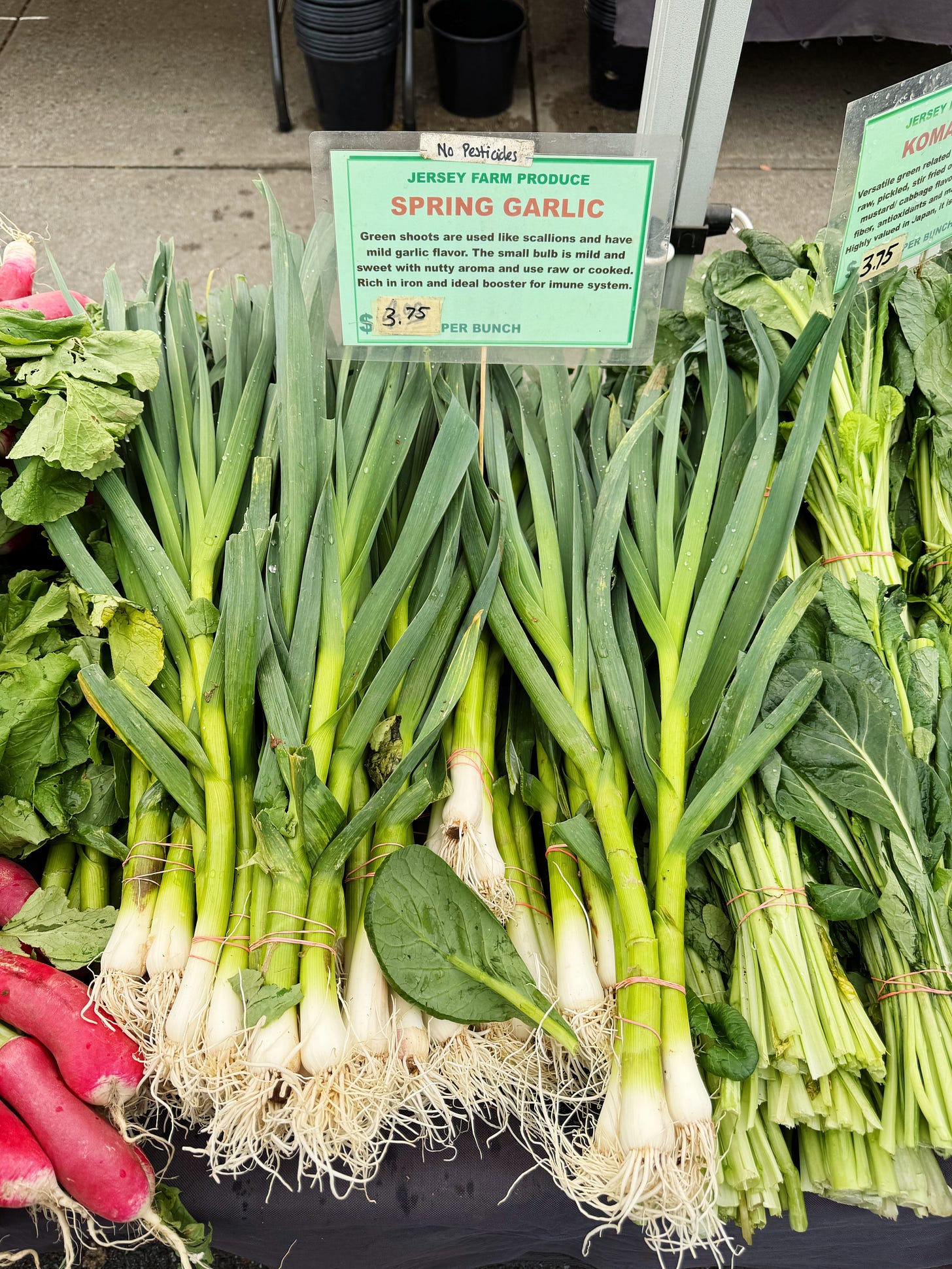
Hello and welcome to A Newsletter! If you’ve found your way over by some miracle but are not yet subscribed, here, let me help you with that:

For anyone living in Hardiness Zones 4–7, spring is mostly an illusion, one we fake by buying tulips at the bodega, wearing the jacket that works for two weeks a year and using frozen peas (and liking it! Frozen peas are great). Over here, even by mid-May, there are no perfect strawberries, no abundance of peas— It’s still a lot of potatoes, little to no fruit, and (as of last week), maybe some green garlic and a few bunches of asparagus (nice). As someone who genuinely appreciates true seasonality and limited edition produce, this is one of my favorite things about living on the east coast. I like not being able to get everything when I want it! It’s all the more special when you can— genuine, organic exclusivity is very appealing to me.
Though, there are a few niche items lurking around that scream spring— the flowering rabe, the fresh, tiny green fava beans, the new purple potatoes still caked in dirt— and while I cook with them in the privacy of my own home, I rarely write recipes for any of those specialty items. Even within New York, availability ranges from week to week, from market to market, and lord knows, I hate to be exclusionary! One thing that doesn’t mind being exclusionary though, is a ramp. A ramp, if you are not familiar, is a tiny little allium, unable to be cultivated and thus only offered wild, with an edible bulb and leaf. They’re also known as “a wild leek,” though the flavor is far more garlicky than that (though I suppose that is a leek….gone wild).
If you like food and cook often, you are almost certainly familiar with ramps, perhaps overly so. You might even be “sick of them” and you might be thinking “ramps are not cool or cool to talk about.” And sure, I get it. This time of year, ramps are “everywhere.” Every pizza restaurant has a ramp special, Via Carota serves them sauteed over griddled polenta (v good), even the bagel shop near me has “ramp cream cheese”. And then…they’re gone. We don’t talk about them for another 11 months until they come back around and someone writes a newsletter about ramps, also known as “a wild leek,” though the flavor is….
Anyway, I like this! I like the fleeting presence of ramps, the withholding, the excitement of foraging for them if you’re lucky enough to do so, the knowledge that you’ll probably not find them in a regular grocery store, thus making their discovery at a farmers market all the more thrilling! Maybe motherhood has softened me, but I no longer tolerate ramp slander. Being too cool to be enchanted by a miracle of spring is boring!
But this is not about ramps, not specifically. We live in an unfortunate time where every few months someone writes an article about beans and how cool they are all of a sudden (?), but I have long stood against the discourse of a vegetable being popular or not, because, well, they’re vegetables (or beans). They are not a capri pant (which are…back?) or a style of shoe. There is a finite number of them, all of them in constant rotation in some combination or another.

I enjoy over-the-top enthusiasm for produce and while spring is the most niche season to show it, I want to show it! I’ll start with this pasta recipe. It ended up as a sort of springy pasta alla Gricia, with pork fat (though you can make this without), buttered peas, pea shoots tossed with fresh lemon and lots of green garlic– an ingredient that can be replaced with regular garlic but know that it will never be the same.
Wednesday, paid subscribers will get a recipe for a perfect chicken that I roasted with spring turnips and their greens (and yes, lots of green garlic). Until then, the spring produce hotline is open (in the comments section below). See you tomorrow.
For all those spring things you look at and think, “What should I do with this?”, this pasta is the answer. Every green leafy thing, garlicky stalk or flowering something: into this pasta it goes! Use the measurements as a suggestion! Ignore them completely! The goal is a sort of spring-y Alla Gricia (pork fat + lots of black pepper + spring vegetables), so this pasta is ideally made with guanciale, green garlic, pea shoots and fresh peas. But know that even if made with olive oil, regular garlic, arugula and frozen peas, it’ll still be so lovely.
1. If using, heat pork in a large skillet over medium heat and cook, stirring occasionally, until the fat has started to render and the edges turn nicely browned (you’re not looking for crispy pork, but well-rendered, soft, golden brown pork), 8–10 minutes.
2. Meanwhile, cook pasta in a large pot of well-salted water until just al dente. Drain, reserving 2 cups pasta water.
3. Once pork is where you want it, take a little bite of one piece and think “wow, that pork is so good and so salty.” From there (or if you’re not using pork), add 3 tablespoons butter, letting it melt and foam up before adding about ¾ of the green garlic and all of the peas (if using frozen, just add from frozen, no need to thaw). Season with salt and lots (and lots) of pepper and cook, stirring occasionally until the green garlic is tender (not browned) and peas are bright green and soft, 3–6 minutes (depending if peas are fresh or frozen).
4. Add pasta to the skillet along with half the pea shoots, ¼ cup of Pecorino and 1 cup pasta water. Cook, tossing constantly until the greens are wilted, the cheese is melted, the sauce has thickened and the pasta is cooked through, adding splashes of pasta water as needed to keep things saucy but not soupy, 2–4 minutes.
5. Remove pasta from heat and top with remaining green garlic, remaining pea shoots and 2 tablespoons lemon juice. Season with salt and pepper and toss, just to incorporate and wilt the shoots slightly (they should remain perky, almost like salad greens or herbs). Divide among bowls and top with more lemon juice, black pepper and Pecorino, if you like.
Thank you to Sézane for sponsoring this week’s newsletter—if you’re looking to cart around the flowered rapini, green garlic, and pea shoots you bring home from the farmers market (or anything else!), I highly recommend the Justine Basket.

